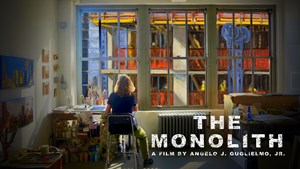
The Monolith offers a visually striking documentary short about celebrated New York City artist, Gwyneth Leech.
The Monolith offers a visually striking documentary short about celebrated New York City artist, Gwyneth Leech. Leech learns that that the skyline view from her midtown art studio will become blocked by the construction of a high-rise hotel. As the perspective outside her window permanently changes, so does the artist's point of view. The Monolith is directed by Angelo J. Guglielmo, Jr., noted for his award-winning documentary The Woman Who Wasn't There. The Monolith is edited by Rosie Walunas, known for her work with character-driven documentaries and non-fiction television. ArtDependence spoke with Guglielmo, Walunas and Leech to learn more about the The Monolith, its metaphors and how the film applies broadly to all lived experience.
AD: The Monolith packs a great deal of narrative and emotion into a brief timeline. How does the experience of making a short film compare to working on a full-length production?
Angelo Guglielmo: A short format can be challenging because you have so little time to say so much. The choices are always how to convey the biggest story by making every sentence, word and scene count.
Rosie Walunas: As an editor, I was thinking about visual effects all along the way. No part of the film’s editing or inclusion is random. I wanted to highlight and select what to focus on, to convey the story in the best possible way, both visually and verbally. There are a ton of gems, there are ton of soundbites. You could just listen to Gwyneth’s story and be compelled. So much happens behind the scenes, behind the images to recreate someone’s moment for them. In every aspect of storytelling, there is a very intentional complementarity to achieve the feeling of that moment. Editing a short film isn’t that different from editing a longer piece. You still have to tell a complete, concise and compelling story. All the same principles apply. A short film is more about telling a very specific story, while a longer film or series is about telling a great big story with many other sub stories within it.
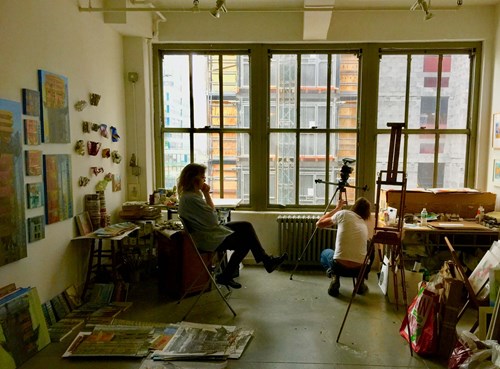
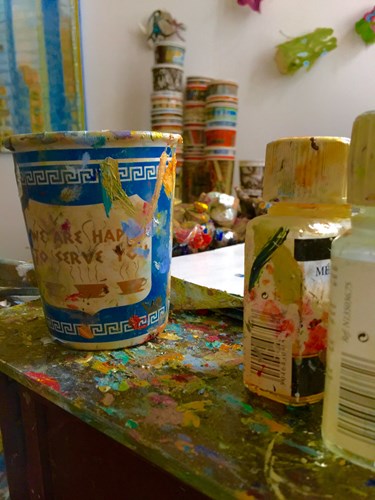
AD: Angelo, what led you to choose artist Gwyneth Leech and her personal experiences as the focus of the film?
Angelo Guglielmo: It all started with Gwyneth and who she is. We have been friends for a long time and I knew she was going through a difficult moment in her life, so much was shifting at once. Losing the view from her window, so precious to her art, became a metaphor for her personal crossroads. The story became less about the view and her art and more about her ability to surrender to and find new inspiration within the change. There is a very relatable quality to her personal journey and that is what the film intends to capture.
AD: Gwyneth, this film is an incredibly vulnerable portrait, not only of your artistic life but of your personal life as well. Was it difficult to share your world so openly and visibly?
Gwyneth Leech: It was difficult because the film takes a turn into complicated emotions, but it also felt very intimate. Nothing was rehearsed. The conversations and ultimately the film came out of my friendship with Angelo. I trusted him and that comes across.
AD: Rosie, there is a very raw quality to the portrayal of Gwyneth. How did you design the film to achieve such a genuine, unguarded effect?
Rosie Walunas: When someone is sharing a story, you can tell where the emotions lie. It is definitely something you can hear in the subject’s voice. In editing, you are always studying people’s emotions, considering the best choices for pacing, music, cuts. When you know what you want to express, you inherently know the editing decisions to make. Subjects often meter themselves in their speech and everyone has their own pace. Once you get a sense of that, you can condense what they say while conveying their emotions. It's all about recreating that moment that the subject once lived.
AD: New York City is a transient environment by nature - visually, architecturally and otherwise. How does the dynamic backdrop encourage transformation and renewal for people within the environment? Are resilience and willingness to change a consequence of inspiration or necessity?
Angelo Guglielmo: Inspiration - to live here, we are required to change and transform. The more we resist it, the less likely we are to find a fulfilling experience. Gwyneth found a deeper understanding within her change. Intellect leads us to absolutes, but instinct leads us to what is emotional, personal and inspiring.
Gwyneth Leech: Living in New York City, there is tension between knowing and loving the city for its familiar faces and places and also being open to change. It is a place in constant flux, culturally and physically. My art practice has been about recording change in different ways and it helps to be resilient, but it isn't always easy. I get attached to things. I have been in my studio space for almost 9 years and part of my daily process has always been looking out at the skyline and taking photos of the view...There is a strong element of grief, knowing that something is coming that you cannot stop, that change is inevitable. At the same time, I got very interested and enthusiastic about it. I could have left my studio around the time that construction began, my lease was up, but I decided that I was going to stay with a determination to experience the transformation. It was a choice to see the positive and look at process through an artist’s lens. In the repeated looking, I saw something fascinating and it became more and more heartening.
Rosie Walunas: In my view, the city forces us to adapt. You change and those changes become part of who you are and how you live your life. Sometimes you surprise yourself when the changes you are prompted to make wind up being changes for the better.
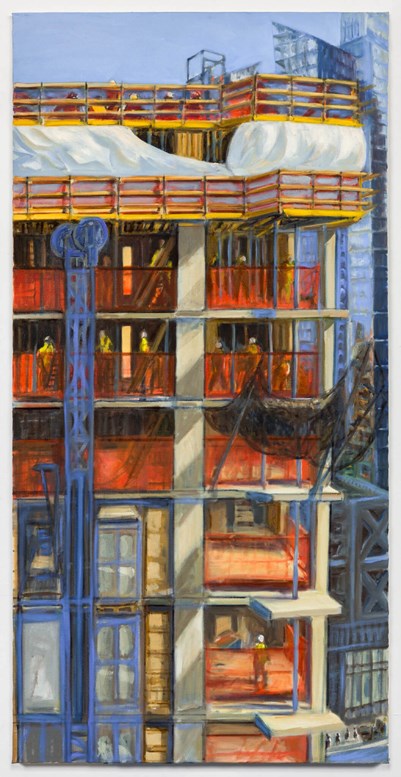
Gwyneth Leech Early Morning Worksite on 40th Street, 2016. Photography by Jeanette May.
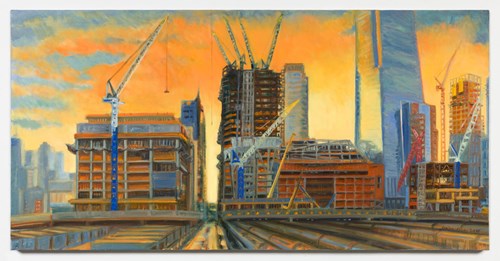
Gwyneth Leech Hudson Yards September Morning, 2016. Photography by Jeanette May.
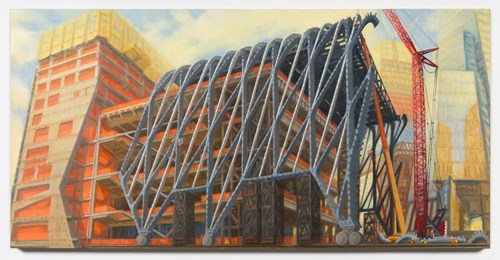
Gwyneth Leech The Shed Under Construction, June 2017. Photography by Jeanette May.
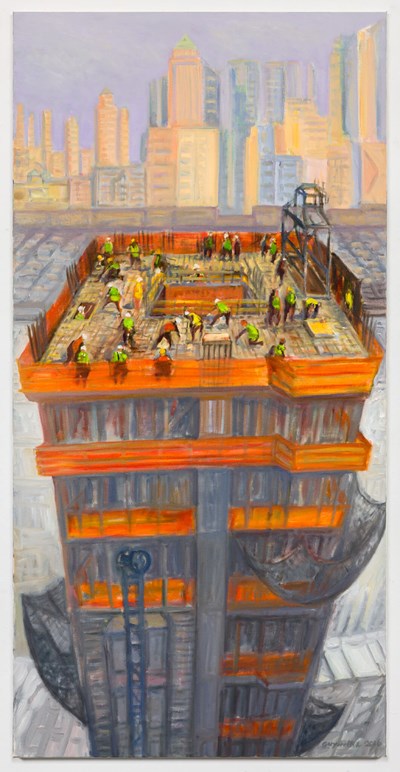
Gwyneth Leech Tower Rising, Midtown, Winter 2016. Photography by Jeanette May.
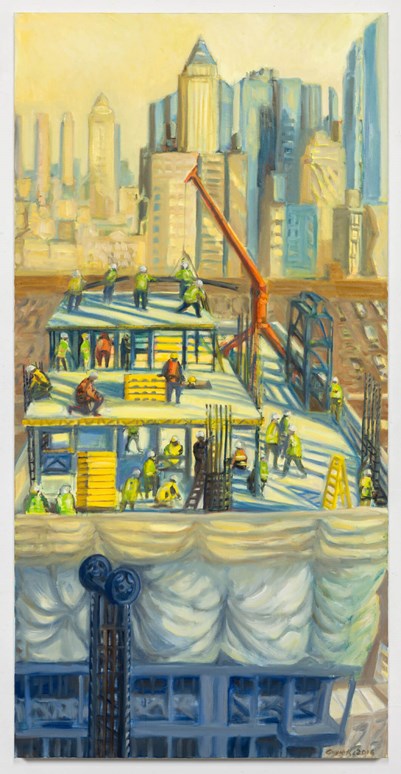
Gwyneth Leech Worksite at Dawn, Winter 2016. Photography by Jeanette May.
AD: The film begins with Gwyneth saying, “I procrastinate” and describing the difficulties of getting into the studio - motivation, the crush of an urban commute. Then the film’s mood lifts when she describes working as an artist, her coffee cup series. Throughout the film, there are moments where the overall sentiment seems to rise then fall then rise again. What does the tumult of this cadence express about life and the inevitability of change?
Angelo Guglielmo: You start with the narrative on the surface because in this medium, a hook to a story is important. Then, you shift into a metaphoric storytelling device - in this case, the building that is going up in front of Gwyneth’s window. The way she spoke about it was a metaphor for all artists and the creation process. I set out to make a film about how procrastination can lead to creation and within that, other themes emerged. As a director, you often don’t know exactly what you want to say until you finish shooting. The film largely became about confronting life's monoliths. Through darkness, self-doubt and shifting circumstances, we still must find the desire to create and express ourselves. Making this film changed my life on many levels. A finished film always takes you to a place where you were not before.
Rosie Walunas: There is always something in our lives - some monolith, something blocking us, something to be desired. It really is how you decide to deal with it that matters. Personally, when I am in that situation, I like to be in nature as a way to regroup. For anyone though, you need to find a meaningful physical or mental place to tackle the difficulties more readily and use positive experiences to inform your perspective. The goal is not to escape but to refocus and reframe life experiences that create happiness. When a block comes up, no one wants that narrative but you have to decide and create what you want your ultimate narrative to be.
AD: Angelo, you have said of your experience in knowing and working with Gwyneth: “I really started to realize that we make a choice how we handle our disappointments and our tragedies.” Expound upon your thoughts there.
Angelo Guglielmo: We all face disappointment in the staggering road to find our genius. Life gets in the way, money gets in the way, relationships get in the way. All of this plays a role in how we create, everything hinges on our choices in how we deal with it. Gwyneth’s struggle is a universal one - art does not come easily, it requires compromises and shifts. You have to be willing to bend with the change to keep moving - in any direction. You navigate a maze of insecurities while creating, which is a powerful affirmation of what we all feel in art and in life.
AD: Gwyneth, at one point in the film you say: “Like many artists, I get blocked. I hit a void. I feel each artwork is an artwork between me and the void.” Describe how you work past your own monoliths as an artist.
Gwyneth Leech: Routine is important, getting into the studio, then being in the moment. There are many times in the studio when I am just sitting, looking and being still, allowing something to come into focus. Those times are important because it is easy to create a lot of distractions for ourselves. Then I start to draw or paint and through the work comes the impetus to continue. I hate being blocked, feeling restless and unable to move ahead…Once I accepted that the building was going up, I was actually filled with momentum, watching the change outside my window. It filled me with hope to see what was behind the change – the effort, the coordination, the technical ability of the construction workers going through their building routine day by day. Watching a myriad of small changes turn into a giant edifice gave me a lot of energy for my own work. I was talking to another artist who said that she needs to make her work or else she is not happy. I can definitely relate to that - I show up, I make the work and it keeps me going. It is not about waiting for inspiration, but doing and creating, and becoming inspired in the process.

ArtDependence Magazine is an international magazine covering all spheres of contemporary art, as well as modern and classical art.
ArtDependence features the latest art news, highlighting interviews with today’s most influential artists, galleries, curators, collectors, fair directors and individuals at the axis of the arts.
The magazine also covers series of articles and reviews on critical art events, new publications and other foremost happenings in the art world.
If you would like to submit events or editorial content to ArtDependence Magazine, please feel free to reach the magazine via the contact page.